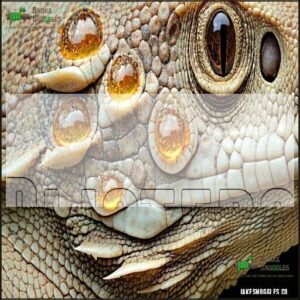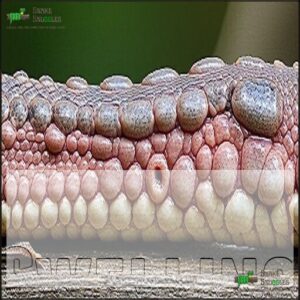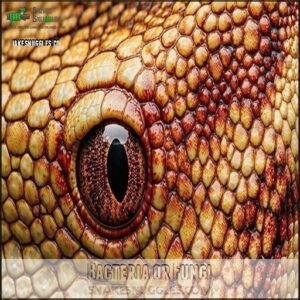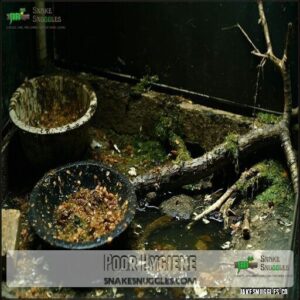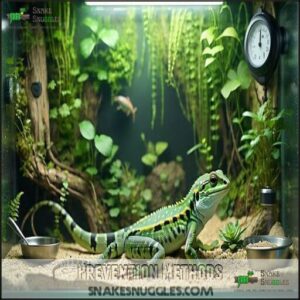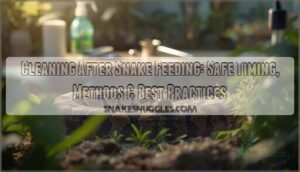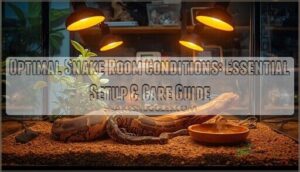This site is supported by our readers. We may earn a commission, at no cost to you, if you purchase through links.

You’ll notice discoloration, blisters, or raised scales that may progress to open wounds if left untreated.
This condition typically stems from excessive humidity, dirty enclosures, or prolonged contact with wet substrate – like a perfect storm for bacteria to throw a party on your pet’s scales.
You’ll need to address it quickly with proper cleaning, environmental adjustments, and possibly veterinary medication.
Understanding the early warning signs can be the difference between a simple fix and a scaled-up emergency requiring intensive treatment.
Table Of Contents
- Key Takeaways
- Symptoms of Scale Rot
- Causes of Scale Rot
- Early Signs & Detection
- Prevention Methods
- Treatment Options
- Behind The Scenes
- Frequently Asked Questions (FAQs)
- What happens if scale rot is left untreated?
- What is scale rot in snakes?
- What is scale rot?
- Is scale rot a bacterial infection?
- Can scale rot be cured?
- How to prevent scale rot in snakes?
- Is Scale Rot Contagious to Other Animals?
- Are There Any Over-the-counter Treatments for Scale Rot?
- Are There Any Home Remedies for Scale Rot?
- Are There Any Long-term Effects of Scale Rot?
- Conclusion
Key Takeaways
- You’ll need to watch for early warning signs of scale rot like reddish-brown spots, discoloration, or swelling on your reptile’s belly scales, as catching these symptoms early prevents a scaled-up emergency.
- Your reptile’s enclosure needs proper maintenance with controlled humidity levels, clean substrate, and good ventilation to prevent the bacterial or fungal infections that cause scale rot.
- You should perform regular inspections of your pet’s habitat and scales, especially ventral areas that contact substrate, to detect problems before they progress to dangerous blisters or ulcers.
- You’ll find that prompt treatment combining veterinary antibiotics, proper cleaning, and supportive care offers the best chance of curing scale rot and preventing potentially fatal complications like septicemia.
Symptoms of Scale Rot
You’ll notice scale rot first as discolored patches on your reptile’s belly scales, often appearing brownish, yellow, or black with potential blisters or swelling in more advanced cases.
When checking your pet during handling sessions, pay special attention to ventral scales that frequently contact substrate, as these areas commonly show the earliest warning signs of this bacterial infection.
Discoloration
To identify scale rot in reptiles, examine your pet’s scales for noticeable discoloration – often the earliest warning sign of this dangerous condition.
When healthy scales transform into unusual hues, it’s time to act fast.
Watch for these telltale discoloration types:
- Brown patches: Early pigment degradation, typically appearing on ventral scales
- Yellow spots: Signal localized irritation and potential infection sites
- Red lesions: Indicate inflammation and possible blood pooling beneath scales
- Blackened areas: Suggest necrotic tissue requiring immediate attention
- Greenish-black discoloration: Advanced bacterial colonization, often with a distinctive odor
The severity levels progress from light spotting to complete color transformation.
Discoloration location matters too – belly scales touching substrate show symptoms first.
Don’t mistake normal shedding for scale rot; identifying hues correctly guarantees timely treatment before blisters form.
Blisters
What exactly do blisters look like when your reptile has scale rot? These fluid-filled bumps typically appear first on scales touching the substrate, signaling vesicular dermatitis. You’ll notice small, raised scale blisters containing clear or yellowish fluid—these are blister formations you shouldn’t ignore.
Different blister types indicate varying severity levels. When blisters rupture, they create entry points for further infection. Blister location matters too; ventral (belly) blisters are most common and concerning.
Early detection prevents dangerous blister complications that could turn deadly if left untreated.
Swelling
During advanced stages of scale rot, you’ll notice significant swelling as inflammation and fluid accumulate beneath your reptile’s scales.
This swelling indicates the bacterial infection is progressing deeper into tissue layers.
- Raised scales appear elevated above surrounding areas, often with discolored patches
- Fluid-filled bumps form primarily along the belly where scales contact substrate
- Increased thickness in affected areas signals worsening infection requiring immediate attention
Damaged Scales
Beyond swelling, damaged scales represent a serious warning sign of advancing scale rot.
When healthy snake scales lose their integrity, they become rough, flaky, or completely peel away – leaving your reptile’s skin defenseless against bacterial infection.
Sharp enclosure hazards often create trauma impact points where infections start. During shedding issues, damaged areas can’t heal properly, worsening the condition.
Watch for scales that appear brittle or uneven – they’re literally your snake’s armor falling apart. Early detection is essential for effective treatment.
Without intervention, these wounds can become permanent scars or worse.
Causes of Scale Rot
You’ll find that scale rot in your reptile is primarily caused by bacteria or fungi that thrive in damp, dirty environments with poor temperature regulation.
Your pet’s risk increases dramatically when you don’t maintain proper hygiene, allow excessive moisture in the enclosure, or fail to treat damaged scales that create entry points for infection.
Bacteria or Fungi
At the root of scale rot lurks microscopic enemies: bacteria and fungi that invade your reptile’s vulnerable skin.
Microscopic invaders lurk unseen, turning your reptile’s protective scales into their battleground for survival.
These pathogens flourish in damp enclosures where environmental factors create perfect breeding grounds.
When your pet’s immune system weakens, bacterial infections can penetrate through tiny cracks in scales, particularly along the belly.
Different bacterial types, including Pseudomonas and Aeromonas, may cause varying symptoms and show antibiotic resistance.
For protection against these infection pathways, follow these steps:
- Monitor humidity levels – Match precisely to your species’ requirements
- Implement weekly cleaning – Use reptile-safe antiseptics for thorough disinfection
- Select appropriate substrate – Avoid materials that trap moisture
- Conduct regular health checks – Examine scales for early signs of fungal species
- Ensure proper ventilation – Prevent condensation that promotes microbial growth
Early intervention with appropriate antibiotics or antifungal treatments can prevent scale rot from progressing to dangerous systemic infections.
Poor Hygiene
While bacteria and fungi are the infectious agents, poor hygiene creates their perfect playground.
Your reptile’s enclosure becomes a microbial paradise when waste buildup and soiled substrate accumulate.
A dirty habitat drastically increases scale rot risk. One key factor is elevated humidity levels, which accelerates bacterial growth.
Here’s why cage hygiene matters:
| Poor Hygiene Factor | Impact on Scale Rot Risk |
|---|---|
| Waste Buildup | Creates bacterial hotspots |
| Soiled Substrate | Harbors harmful pathogens |
| Dirty Water Dishes | Spreads bacteria to scales |
| Unwashed Décor | Forms biofilms that infect |
| Irregular Cleaning | Allows fungal infections to establish |
"My ball python got scale rot after I skipped cleanings for two weeks," one owner confessed. "Don’t make my mistake—enclosure hygiene isn’t optional, it’s life-saving protection against scale rot.
Excessive Moisture
While maintaining good hygiene is critical, excessive moisture creates an equally dangerous environment for your reptile.
When water accumulates in your pet’s enclosure, you’re basically rolling out the red carpet for scale rot. Improper humidity monitoring allows moisture levels to climb dangerously high.
Your substrate choice matters tremendously here—materials that retain water create perfect conditions for bacterial and fungal infections to flourish. Water spillage from dishes or excessive misting can saturate bedding, keeping your reptile’s scales constantly damp and vulnerable.
Without proper enclosure ventilation, this moisture becomes trapped, creating a humid microclimate that weakens scale integrity. You’ll often notice shedding problems as an early warning sign—incomplete sheds indicate humidity issues that can lead to scale rot.
To protect your reptile:
Maintain species-appropriate humidity levels using a reliable hygrometer
Select substrates that balance moisture without becoming waterlogged
Address spills immediately
Make certain adequate airflow throughout the habitat
Remember: preventing excessive moisture is far easier than treating the infections it causes.
Early Signs & Detection
You’ll spot scale rot early by checking your reptile’s belly scales for subtle brownish or reddish discoloration, often resembling tiny burns along the edges where scales meet the substrate.
Monitoring behavioral changes, such as unusual restlessness or excessive rubbing against tank objects, can alert you to discomfort before visible symptoms progress to dangerous blisters or ulcers, which can be a sign of scale rot.
Red Spots in Scales
While monitoring your reptile’s health, red spots on scales often serve as the first warning flag of scale rot.
These subtle crimson marks typically appear on your pet’s belly where scales contact substrate, signaling the early stages of a bacterial infection that requires prompt attention.
Red spot causes range from bacterial growth to physical trauma, with moisture often being the culprit. Don’t confuse these warning signs with normal shedding patterns—spot location makes a difference.
Here’s what to check for when examining your reptile:
- Belly scales showing pink to bright red discoloration
- Edge patterns where spots appear along scale borders
- Color progression from red to brown, yellow, or black
- Texture changes like raised or bubbling scales
- Spread patterns indicating spot severity is increasing
Snake scale rot symptoms worsen quickly, so inspect your pet weekly. What looks like a harmless red dot today could develop into serious scale rot tomorrow if left untreated. Quick identification saves lives!
Stress Indicators
While those red spots on scales might signal early infection, your reptile’s behavior speaks volumes about their health too.
Stress weakens your pet’s immune system, making them vulnerable to scale rot and other conditions.
Watch for these telltale stress indicators that could warn of developing health problems:
- Appetite Changes: When your normally hungry snake suddenly turns down meals or eats less than usual, it’s often their way of saying something’s wrong.
- Hiding Behavior & Lethargy: Excessive hiding, reduced activity levels, or unusual stillness can indicate your reptile isn’t feeling their best.
- Shedding Issues: Incomplete sheds or more frequent shedding attempts may point to stress or developing skin problems.
You’ll also notice defensive postures in stressed reptiles—they’re not just being moody!
These behavior changes often precede visible scale problems, giving you a chance to address issues before infection takes hold.
Prevention Methods
You’ll save yourself countless hours of worry and expensive vet bills by maintaining proper humidity levels and regularly inspecting your reptile’s habitat for cleanliness.
Keeping substrate dry, managing temperature gradients correctly, and promptly removing waste or uneaten food will substantially reduce your pet’s risk of developing this painful bacterial infection, which can be a significant concern for reptile owners aiming to prevent infection.
Clean & Ventilate Habitat
Now that you can spot the early warning signs, let’s talk about keeping your reptile’s home spotless.
Your snake enclosure cleaning routine is the first line of defense against scale rot. Remove waste daily, replace substrate weekly, and deep clean monthly.
Proper ventilation prevents humidity buildup while maintaining appropriate moisture levels. Choose substrates that won’t retain excessive moisture, and make certain your enclosure size allows adequate airflow.
Selecting the right reptile habitat cleaner is vital for hygiene.
Cage cleanliness isn’t just about aesthetics—it’s life-saving snake healthcare.
Regular Inspections
Once your habitat is clean, your defense plan needs regular inspections.
For effective early detection, examine your reptile daily with special attention to ventral scales and the cloacal region where scale rot commonly begins.
Use proper handling techniques during your snake scale examination—avoid checking after meals when stress levels are high.
During detailed examinations, use a flashlight to assess snake scale color and texture changes.
Implement quarantine protocols immediately if you spot raised scales, as this indicates blood pooling beneath the surface.
One early sign is brownish scale discoloration, which can be a critical indicator of scale rot.
Frequency matters—daily quick checks paired with weekly thorough inspections create a safety net.
Document any changes in a health journal; photos help track progress.
Remember, vigilance prevents emergencies, and regular checks are crucial for the health of your reptile.
By following these steps, you can ensure the well-being of your pet and prevent serious health issues.
Treatment Options
You’ll need to act quickly once you’ve spotted signs of scale rot in your reptile, as effective treatment combines both veterinary intervention and proper home care.
When caught early, most cases can be successfully treated with a combination of topical antiseptics, antibiotic medications, and improved habitat conditions that address the underlying causes, which is crucial for effective treatment.
Veterinary Antibiotics
After keeping your reptile’s habitat clean, your next defense against scale rot is proper medication. Veterinary antibiotics serve as the frontline treatment when bacterial infections take hold of your pet’s scales.
Your vet may prescribe topical antibiotic ointments for mild cases, applying them directly to affected areas after cleaning. For more severe snake bacterial infection, systemic antibiotics through injections or oral medications become necessary.
"Treatment duration typically ranges from 3-6 weeks depending on severity," notes Dr. Roberts, an experienced reptile veterinarian.
Watch for side effects like decreased appetite or lethargy during treatment. Consider reptile antibiotic options for effective treatment. Proper dosage calculation is critical—too little won’t eliminate the infection, while too much risks antibiotic resistance.
Injection techniques matter too; your vet can demonstrate proper administration if you’re treating at home.
Remember, veterinary care offers the best chance for your scaled friend’s complete recovery from scale rot.
Supportive Care
While medications battle the infection, supportive care works as your reptile’s personal recovery team.
Proper quarantine protocols prevent spreading the infection to other animals in your collection.
During treatment, replace traditional substrates with paper towels—they’re easier to change and keep clean.
Hydration methods are vital; maintain a small water dish that won’t allow soaking but provides adequate drinking water.
Nutrition importance can’t be overstated.
Feed your snake nutrient-dense meals rich in vitamins A and C to boost immune function.
Adjust temperature and humidity to ideal levels for your species to support healing.
To confirm proper care, consider annual snake checkups with a reptile veterinarian.
Practice stress reduction by minimizing handling and maintaining a quiet environment.
Perform gentle wound care with chlorhexidine twice daily to keep affected areas clean.
- Think of supportive care as building a healing sanctuary—every element from bedding to temperature works together to help your scaly friend recover.
Behind The Scenes
While we’ve covered treatment options, success in battling scale rot depends on what happens behind the scenes.
Research insights show that prevention beats cure every time.
| Prevention Factor | Expert Opinion | Impact on Scale Rot | Future Direction |
|---|---|---|---|
| Habitat Cleanliness | Critical daily need | Prevents bacterial growth | Automated monitoring |
| Humidity Control | Must match species | Reduces fungal infections | Smart sensors |
| Temperature Regulation | Species-specific | Strengthens immune system | Gradient heating |
| Health Monitoring | Weekly checks | Catches early signs | AI-assisted detection |
You’ll want to think of your reptile’s enclosure as its fortress against infection.
Breeding practices and genetic predispositions can influence susceptibility, but proper husbandry remains your best defense.
Check your snake’s ventral scales regularly—they’re often the first to show trouble.
Remember that small lapses in care can create big problems, so consistency is key in snake scale rot prevention and management.
It’s crucial to maintain a species-specific environment to prevent scale rot, and ensure you’re providing the best care for your reptile.
Frequently Asked Questions (FAQs)
What happens if scale rot is left untreated?
Untreated infections will spread beyond the skin, potentially causing septicemia (blood poisoning) that can be fatal.
You’ll notice your snake becoming lethargic, refusing food, and developing more severe symptoms as the condition worsens.
What is scale rot in snakes?
Scale rot is a bacterial infection that affects your snake’s scales, appearing as discolored patches, blisters, or raised scales on their belly.
It’s caused by poor enclosure conditions and can become deadly if left untreated, making prompt action crucial for the snake’s health, with bacterial infection being a key factor.
What is scale rot?
Your healthy snake can quickly face danger as scale rot develops.
This bacterial infection attacks your reptile’s scales, appearing as discolored, blistered, or raised areas, typically on the belly.
It’s caused by poor enclosure conditions.
Is scale rot a bacterial infection?
Yes, scale rot is primarily a bacterial infection that affects reptiles, particularly snakes.
It’s commonly caused by bacteria entering through damaged scales when your pet is exposed to poor, damp conditions in their enclosure.
Can scale rot be cured?
Over 90% of scale rot cases can be completely cured with proper treatment.
You’ll need to clean affected areas with antiseptics, apply prescribed medications, and fix the environmental issues that caused the infection initially, which can lead to a complete cure.
How to prevent scale rot in snakes?
Keep your pet’s environment clean and dry with proper humidity levels.
Replace substrate regularly, maintain ideal temperatures, and promptly treat any injuries.
Regular health checks will catch early warning signs before they escalate, ensuring a safe and clean environment for your pet.
Is Scale Rot Contagious to Other Animals?
While you might worry about cross-species transmission, scale rot isn’t contagious to non-reptiles.
It can, however, spread between snakes and other reptiles when they share contaminated environments.
You’ll need to isolate affected animals immediately.
Are There Any Over-the-counter Treatments for Scale Rot?
You can treat mild cases with chlorhexidine solution, diluted betadine (1:3 ratio), or over-the-counter triple antibiotic ointment without pain relief. These should be applied after cleaning the affected area twice daily.
Are There Any Home Remedies for Scale Rot?
A desperate snake owner once used diluted betadine soaks when veterinary care wasn’t available.
You can try betadine baths (1:10 ratio), paper towel substrate, and chlorhexidine cleaning for mild cases.
Severe infections need professional treatment.
Are There Any Long-term Effects of Scale Rot?
Untreated infections can lead to permanent scale damage, septicemia, and death. You’ll notice scarring where scales don’t grow back properly, and your snake might develop recurring infections in vulnerable areas.
Conclusion
Vigilance saves reptiles while neglect endangers them.
By monitoring your pet’s scales regularly, you’ll catch scale rot before it becomes life-threatening.
Remember, prevention requires less effort than treatment—maintain proper humidity, clean enclosures weekly, and provide dry areas for your reptile to rest.
Don’t hesitate to consult a vet if you notice any suspicious changes, as your quick action can mean the difference between a healthy pet and one suffering from advanced scale rot, emphasizing the importance of proper humidity.
- http://veterinarymedicinejournal.usamv.ro/pdf/vol.LVIII_4/Art12.pdf
- https://www.petmd.com/reptile/conditions/cardiovascular/c_rp_septicemia
- https://dr.lib.iastate.edu/server/api/core/bitstreams/15df7db7-a2d8-4513-a541-ac1aff2bc49a/content
- https://www.wildlifedemonstrations.com/post/scale-rot-how-to-identify-and-treat


